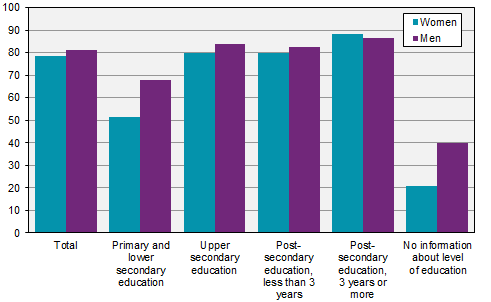Education and employment in the population, 2014:
Highly educated persons gainfully employed to a greater extent
Statistical news from Statistics Sweden 2016-06-22 9.30
There is a distinct relation between level of education and the proportion of the population that is gainfully employed. The highly educated part of the population is gainfully employed to greater extent than those with a lower level of education.
‘Highly educated’ here refers to persons with a post-secondary education of at least three years whereas ‘those with a lower level of education’ refers to people who have only completed compulsory school. In 2014, 80 percent of the population aged 25-64 was gainfully employed. The corresponding percentage among the highly educated was 87 percent. Among those with a lower level of education, 61 percent were gainfully employed.
Women have a higher educational level than men in the population as a whole. This also applies to the gainfully employed. Taken as a total group, women are employed to a lesser extent than men despite the positive relationship between the level of education and being gainfully employed. In 2014, 78 percent of women and 81 percent of men aged 25-64 were gainfully employed. Among the highly educated, women were gainfully employed to a slightly greater extent than men. Among those with only compulsory education, the difference is greater. In this group, 68 percent of the men were gainfully employed, but only 51 percent of the women.
Percent

Highly educated in the counties of Västernorrland and Jämtland were most gainfully employed
The percentage of gainfully employed persons in Swedish counties varies between 75 and 84 percent of the population aged 25-64 years. In most counties, it is around 80 percent. The difference in the proportion of gainfully employed persons is lower among the highly educated than among those with a lower level of education. The counties of Västernorrland and Jämtland had the highest proportion of gainfully employed persons among the highly educated at 91 percent while the county of Skåne had the lowest proportion at 82 percent. The difference between the counties is greater among those with a lower level of education. In total, 61 percent of those with only a compulsory education were gainfully employed. The county of Halland had the highest proportion of gainfully employed persons among those with a lower level of education at 69 percent. In the counties of Uppsala, Jönköping and Gotland, 67 percent of those with a lower level of education were gainfully employed. The lowest proportion of gainfully employed among those with a lower level of education was in the counties of Östergötland, Örebro and Västmanland where it was 56 percent.
Even among Swedish municipalities, there is less of a difference in the proportion of gainfully employed persons among the highly educated compared to among those with a lower level of education. The highly educated in the municipalities of Nykvarn, Habo and Krokom were the most gainfully employed, at 94 percent. The highest proportion of gainfully employed among those with a lower level of education was in the municipalities of Nykvarn and Habo, 81 and 79 percent.
Publication
A more detailed report of this survey are available in a Statistical Report.
Feel free to use the facts from this statistical news but remember to state Source: Statistics Sweden.
